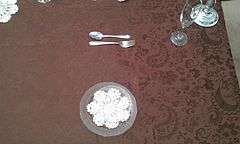Finger bowl


A finger bowl is a bowl of water used for rinsing one's fingers after the last course of a formal meal served à la russe. It is typically brought to the table at the time of the dessert course, arriving atop the dessert plate, with a linen doily between the plate and the bowl and with the dessert fork and spoon on the plate.
Description
If a separate fruit course is to follow dessert, the finger bowl should be brought in at that time, with the fruit fork and knife. Alternatively, a full array of dishes can be brought out at once, with the finger bowl atop the dessert plate with its fork and spoon, and the dessert plate atop the fruit plate, with doilies between each dish; in this type of service, the fruit fork and knife are brought out after the dessert plates and silver are cleared.[1]:208-209 "Where there are plenty of servants, the finger bowl may not come in on the fruit plate but may be brought on its own serving plate, replacing the used fruit plate before the guests leave the table for coffee."[2]:275 A glass ornament, flower, flower petals, lemon slice, sprig of mint or other decoration is often floated in it.[2]:285
Common form
In its most common form, the course begins with the delivery of the dessert or fruit plate with finger bowl and silverware, as one unit. "This is the only time during a formal meal that a guest takes part in placing the appointments for a course";[3]:295 that is, they are responsible for moving the dessert silverware to the sides of the dessert plate, and removing the finger bowl (together with the doily) to the upper left of the plate. The bowl is "less than half"[1]:209 or as much as "three-quarters"[4]:434 filled with water. After dessert (or after the fruit, if it is offered as a separate course), guests lightly dip their fingertips into the water, one hand at a time, and then wipe them on the napkin in their lap.[2]:285
Formal customs
As with most formal customs of etiquette, there are considered to be right and wrong ways to present and use a finger bowl, and these can differ. The acceptability of floating a lemon[1][5] or of using the finger bowl to wet the mouth,[3]:28[4]:435 for example, are disputed. Unfamiliarity with this custom has led to many common faux pas, including drinking the water, eating the flower, or failing to move the doily with the bowl when shifting it off of the dessert plate.[6]
Decline
The decline of the finger bowl in American restaurants was due to the war effort during World War I when everyone was encouraged to minimize excess. However, before that, "live music and finger bowls were two amenities put forward as competitive attractions over places that didn't have them".[5]
In a form of service commonly seen in the early 21st century, guests use the finger bowl before dessert and fruit, rather than after. This innovation, possibly resulting from ignorance of correct usage, is of unknown and apparently recent origin.
A finger bowl that carries the monogram of Ottoman Emperor Abdulhamid II is kept at the Corning Museum of Glass.[7]
See also
References
- 1 2 3 Post, Emily (1922). Etiquette in Society, in Business, in Politics, and at Home. New York: Funk & Wagnalls Company. Retrieved 2017-07-22.
- 1 2 3 Vanderbilt, Amy (1957). Amy Vanderbilt's Complete Book of Etiquette. Garden City, New York: Doubleday & Company, Inc. Retrieved 2017-07-22.
- 1 2 Vogue's Book of Etiquette and Good Manners. New York: The Conde Nast Publications Inc. in association with Simon and Schuster. 1969.
- 1 2 Vanderbilt, Amy (1972). Amy Vanderbilt's Etiquette. Garden City, New York: Doubleday & Company, Inc.
- 1 2 Whitaker, Jan (15 November 2011). "Dipping into the finger bowl". Retrieved 2014-01-26.
- ↑ Baldrige, Letitia (1990). Letitia Baldrige's Complete Guide to the New Manners for the '90s. New York: Rawson Associates. ISBN 0-89256-320-6. :146
- ↑ "Collection Search - Corning Museum of Glass".
Further reading
| Wikimedia Commons has media related to Finger bowls. |
- Witchel, Alex (February 22, 2006) "Ripples in a Finger Bowl", New York Times